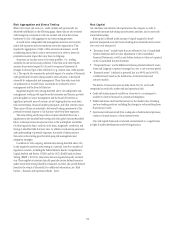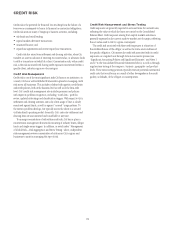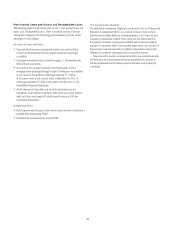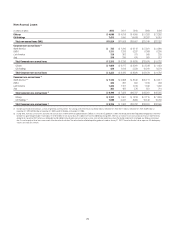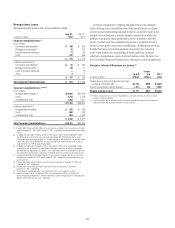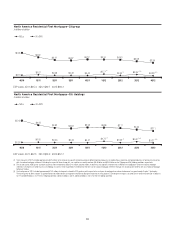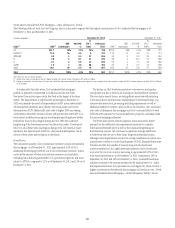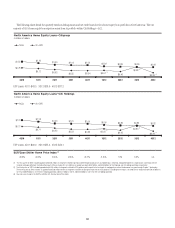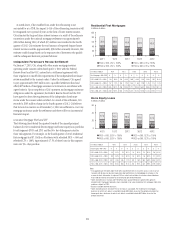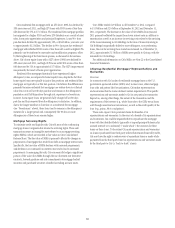Citibank 2012 Annual Report Download - page 105
Download and view the complete annual report
Please find page 105 of the 2012 Citibank annual report below. You can navigate through the pages in the report by either clicking on the pages listed below, or by using the keyword search tool below to find specific information within the annual report.83
North America Consumer Mortgage Lending
Overview
Citi’s North America Consumer mortgage portfolio consists of both
residential first mortgages and home equity loans. As of December 31, 2012,
Citi’s North America Consumer residential first mortgage portfolio totaled
$88.2 billion, while the home equity loan portfolio was $37.2 billion. This
compared to $95.4 billion and $43.5 billion of residential first mortgages
and home equity loans as of December 31, 2011, respectively. Of the first
mortgages at December 31, 2012, $57.7 billion is recorded in LCL within Citi
Holdings, with the remaining $30.5 billion recorded in Citicorp. With respect
to the home equity loan portfolio, $34.1 billion is recorded in LCL, and
$3.1 billion is in Citicorp.
Citi’s residential first mortgage portfolio included $8.5 billion of loans
with FHA insurance or VA guarantees as of December 31, 2012, compared
to $9.2 billion as of December 31, 2011. This portfolio consists of loans to
low-to-moderate-income borrowers with lower FICO (Fair Isaac Corporation)
scores and therefore generally has higher loan-to-value ratios (LTVs). Credit
losses on FHA loans are borne by the sponsoring governmental agency,
provided that the insurance terms have not been rescinded as a result of an
origination defect. With respect to VA loans, the VA establishes a loan-level
loss cap, beyond which Citi is liable for loss. While FHA and VA loans have
high delinquency rates, given the insurance and guarantees, respectively, Citi
has experienced negligible credit losses on these loans.
In addition, as of December 31, 2012, Citi’s residential first mortgage
portfolio included $1.5 billion of loans with LTVs above 80%, compared to
$1.6 billion as of December 31, 2011, most of which are insured through
mortgage insurance companies. As of December 31, 2012, the residential
first mortgage portfolio also had $1.0 billion of loans subject to long-term
standby commitments (LTSC) with U.S. government-sponsored entities
(GSEs), compared to $1.2 billion as of December 31, 2011, for which Citi
has limited exposure to credit losses. Citi’s home equity loan portfolio
also included $0.4 billion of loans subject to LTSCs with GSEs (flat to
December 31, 2011) for which Citi also has limited exposure to credit losses.
These guarantees and commitments may be rescinded in the event of loan
origination defects.
Citi’s allowance for loan loss calculations takes into consideration the
impact of these guarantees and commitments.
Citi does not offer option-adjustable rate mortgages/negative amortizing
mortgage products to its customers. As a result, option-adjustable rate
mortgages/negative amortizing mortgages represent an insignificant portion
of total balances, since they were acquired only incidentally as part of prior
portfolio and business purchases.
As of December 31, 2012, Citi’s North America residential first mortgage
portfolio contained approximately $7.7 billion of adjustable rate mortgages
that are currently required to make a payment only of accrued interest for
the payment period, or an interest-only payment, compared to $8.6 billion
at September 30, 2012 and $11.9 billion at December 31, 2011. The decline
quarter over quarter resulted from conversions to amortizing loans of
$471 million and repayments of $296 million, with the remainder primarily
due to foreclosures and related activities and, to a lesser extent, asset sales.
The decline year over year resulted from conversions to amortizing loans of
$2.3 billion and repayments of $1.5 billion, with the remainder primarily
due to foreclosures and related activities and, to a lesser extent, asset sales.
Borrowers who are currently required to make an interest-only payment
cannot select a lower payment that would negatively amortize the loan.
Residential first mortgages with this payment feature are primarily to
high-credit-quality borrowers who have on average significantly higher
origination and refreshed FICO scores than other loans in the residential first
mortgage portfolio, and have exhibited significantly lower 30+ delinquency
rates as compared with residential first mortgages without this payment
feature. As such, Citi does not believe the residential mortgage loans with this
payment feature represent substantially higher risk in the portfolio.
North America Consumer Mortgage Quarterly Credit Trends—
Delinquencies and Net Credit Losses—Residential First Mortgages
The following charts detail the quarterly trends in delinquencies and net
credit losses for Citigroup’s residential first mortgage portfolio in North
America. Approximately 65% of Citi’s residential first mortgage exposure
arises from its portfolio within Citi Holdings—LCL.


